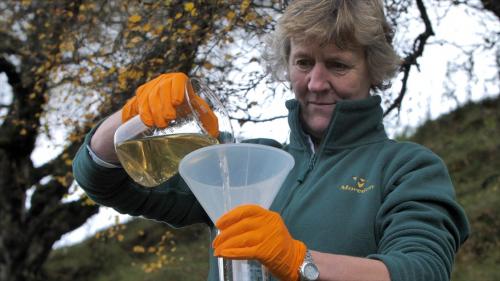The Cryptosporidium oocysts have a tough outer waxy shell, composed of lipids and glycoproteins that enables the parasite to survive in the environment over a wide temperature range (-220C -600C) for several months. As a result, Cryptosporidium parasites are a real problem for the water industry as the parasite survives extremely well in water and is resistant to chlorination. Modelling studies, by other researchers, has also shown that it only requires a very few oocysts to cause infection in humans and animals.
There are around forty different species of Cryptosporidium parasites and not all of them are important in public health. Some species of Cryptosporidium such as C. parvum are zoonotic and can be transmitted between animals and people. Livestock, in particular young calves which are housed for calving, are very vulnerable to infection with the parasite, where it can cause severe diarrhoeal disease resulting in production losses, welfare issues and sometimes death for the affected animals.
In addition to causing severe disease in young livestock, the affected animals will shed millions of infective parasites in their faeces, a source of contamination on the farm which can also act as a source of infection for co-grazing wildlife and ultimately contaminate the wider environment. The resistant nature of the parasite oocysts can aid the contamination of water courses, particularly when livestock and wildlife have access to these, and this becomes a risk to public health. Cryptosporidium parasites are the cause of many human disease outbreaks due to contaminated water supplies. There are currently no vaccines and very few effective therapeutics to treat people, but new sensitive techniques are being developed to enable the detection of Cryptosporidium parasites in faecal samples from farm livestock, wildlife and environmental samples in water catchments.
A recent study, by SEFARI scientists, looked at the presence of zoonotic species of Cryptosporidium parasites in samples collected from cattle and wild geese that co-graze on farms surrounding two reservoirs, supplying drinking water to mainland Orkney. Analysis found C. parvum in both animal species represented a potential risk to public health. Therefore, specific molecular genotyping techniques have been developed and applied to the samples to characterise the Cryptosporidium parasites, this will help to understand the potential sources of contamination for water catchments and inform strategies to mitigate the risk. Current research is looking at multi-locus genotyping techniques that may offer greater discrimination. An aim of the research is to develop a genotyping approach that can be used in both veterinary and public health to enable an integrated One Health approach to disease epidemiology.
With livestock farming moving towards increasingly efficient and sustainable production to minimise impact on the environment, there is much to be gained from tackling cryptosporidiosis. Applying measures to prevent and control cryptosporidiosis in livestock will have significant benefits for livestock health and welfare and increase the efficiency of production bringing economic benefits to livestock farmers. In addition, applying methods on farm to minimise the environmental contamination with faeces containing infective Cryptosporidium oocysts will also help to minimise risk to other animals and to people through protection of the environment and water catchments.
The effective management of manure and slurry on farms to reduce viability of Cryptosporidium oocysts will have an impact on disease risk in the wider environment and in particular for water catchments. Such on farm practices include:
- The proper composting of manure as heat (>60oC) will inactivate the oocysts.
- Storage of faecal waste on farm in slurry tanks, as ammonia and low pH will help to inactivate oocysts.
- Fencing of livestock away from streams and water courses.
- Provision of water troughs.
- Use of vegetated and riparian buffer strips, which can help to slow down the transfer of Cryptosporidium oocysts from livestock faecal matter into water courses.
SEFARI scientists advocate a One health approach to improve the health and welfare of livestock. By controlling infection with zoonotic Cryptosporidium parasites and providing advice on farm waste management strategies to reduce environmental contamination, in particular water catchments, can also help to protect public health. Knowledge exchange and working with relevant stakeholder and industry groups including; farmers, vets, landowners and Scottish Water, together with SEFARI scientists, is key to the success of this approach. Several on farm events have taken place to discuss the multiple benefits of the prevention and control of Cryptosporidium parasites and scientists have even developed some online educational materials in to raise awareness of the parasite and how to tackle it.
A One Health approach is being applied to our research across SEFARI, as exemplified here, to tackle the challenges associated with Cryptosporidium parasites, and this approach routinely involves collaborative working between researchers and different stakeholders.
Professor Elisabeth A Innes and Dr Beth Wells, Moredun Research Institute.
